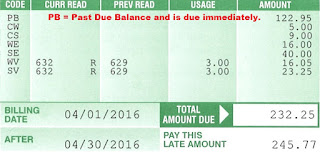UNDERSTANDING
YOUR BILL
Your monthly water & sewer bill contains a lot of
information, which can be a bit overwhelming.
The following example is a typical ECWSA bill. The key
below shows where important information is found.
A. Customer Name.
B. Property Address.
C. Billing Address / Mailing Address.
D. Account Number.
E. Sequence Number – this is a number used by
our meter readers to locate your meter.
F. Billing Date – The date the bill was
generated and the date payment is due.
G. Billing Cycle Dates – The period the billing
is for.
H. Total amount due and the amount due after the
due date, which includes a penalty.
I. Announcements or memos.
J. Meter Reading and Usage
Sometimes our customers get behind on paying their water and sewer bill. When this happens, the next bill will show a “previous / past due balance, designated with the billing code “PB.”
Even though the computer adds
the past due amount into the total balance due of the billing, the PB amount is due immediately.
Meter readings are taken
during the odd numbered months. Even numbered months’ usage charges are
estimated based on the previous twelve months of usage. Sometimes our computer
will estimate usage too low. In this instance, the customer will be charged for
the additional usage on the following billing cycle, after an actual reading.
|
Other times, our computer
may estimate usage too high. When this happens, the customer will see a usage
credit on the next billing cycle, after an actual
reading.
In either case, customers
only pay for water and sewer that they have actually used over a two month
period.
When there is no usage or meter reading listed on
your bill, this means that either the computer estimated that you would
have less than 1000 gallons usage that month, or your meter reading was the
same as the previous month’s
estimated bill.
|
The back of your bill is
where answers to frequently asked questions are found, including:
A. ECWSA Contact
Information.
B. ECWSA Office Hours.
C. Information
regarding late charges.
D. Common Billing
Codes.
Other, less common codes, may
also appear on your bill. If you have any questions about billing codes, please
contact our office and we will happy to explain them.



